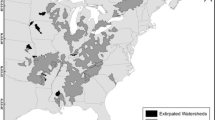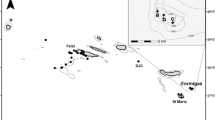Abstract
Since the European population of great cormorants (Phalacrocorax carbo sinensis) rapidly increased 30 years ago, Denmark has been one of the core breeding areas for this colonial water bird. Following a 10-year period with stable breeding numbers in Denmark, the population of great cormorants decreased. At the same time, a combination of cold winters and low availability of coastal prey fish apparently triggered birds to seek new foraging areas. Thus, cormorants began to appear in rivers and streams coinciding with an observed massive decline of fish, mainly brown trout (Salmo trutta) and grayling (Thymallus thymallus). In this paper, we present the results from studies using radio-telemetry, PIT-tagging, and traditional fish surveys to estimate the impact of predation in Danish lowland rivers. Recovery of PIT-tags revealed that an estimated 30% of wild trout and 72% of wild grayling tagged in a small river were eaten by cormorants. In another medium-sized river, 79% of radio-tagged adult grayling were removed, presumably by cormorants during winter. Thus, predation from cormorants appears to be at a level that explains the observed collapse of grayling and brown trout populations in many Danish streams.




Similar content being viewed by others
References
Aarestrup, K., N. Jepsen, A. Koed & S. Pedersen, 2005. Movement and mortality of stocked brown trout in a stream. Journal of Fish Biology 66: 721–728.
Aldomóvar, A. & G. G. Nicola, 2004. Angling impact on conservation of Spanish stream-dwelling brown trout Salmo trutta. Fisheries Management and Ecology 11: 173–182.
Boel, M., 2012. Life history types and strategies. Case studies on brown trout and alewives, involving physiological differences and interspecific interactions. PhD Thesis, DTU Aqua, 133 pp.
Braña, F., A. G. Nicieza & M. M. Toledo, 1992. Effects of angling on population structure of brown trout, Salmo trutta L., in mountain streams of Northern Spain. Hydrobiologia 237: 61–66.
Bregnballe, T., 2009. Skarven. Hovedland, 103 pp (Miljøbiblioteket; Nr. 17).
Bregnballe, T., J. Sterup & M. Frederiksen, 2015. Migration patterns and distribution outside the breeding season of great cormorants from the Danish breeding population. Wetlands International Cormorant Research Group Bulletin 8: 22–24.
Čech, M. & L. Vejřík, 2011. Winter diet of great cormorant (Phalacrocorax carbo) on the River Vltava: estimate of size and species composition and potential for fish stock losses. Folia Zoologica 60: 129–142.
Čech, M., P. Čech, J. Kubečka, M. Prchalová & V. Draštík, 2008. Size selectivity in summer and Winter diets of great cormorant (Phalacrocorax carbo): does it reflect season-dependent difference in foraging efficiency? Waterbirds 31: 438–447.
Dieperink, C., S. Pedersen & M. I. Pedersen, 2001. Estuarine predation on radiotagged wild and domesticated sea trout (Salmo trutta L.) smolts. Ecology of Freshwater Fish 10: 177–183.
Dieperink, C., B. D. Bak, L. Pedersen, S. Pedersen & M. I. Pedersen, 2002. Predation on Atlantic salmon and sea trout during their first days as postsmolts. Journal of Fish Biology 61: 848–852.
Dorr, B. S. & D. G. Fielder, 2017. Double-crested cormorants: too much of a good thing? Fisheries 40(8): 472–481.
Dorr, B. S., A. Moerke, M. Bur, C. Bassett, T. Aderman, D. Traynor, R. Singleton, P. Butchko & J. D. Taylor II, 2010. Evaluation of harassment of migrating double-crested cormorants to limit depredation on selected sport fisheries in Michigan. Journal of Great Lakes Research 36: 213–223.
Dorr, B. S., S. L. Hanisch, P. H. Butchko & D. G. Fielder, 2012. Management of double-crested cormorants to improve sport fisheries in Michigan: 3 case studies. Human–Wildlife Interactions 6: 140–153.
Fielder, D. G., 2010. Response of the Yellow Perch in the Les Cheneaux Islands, Lake Huron to declining numbers of double-crested cormorants stemming from control activities. Journal of Great Lakes Research 36: 207–214.
Fischbacher, M., 1983. Zu Standortwahl und Verhalten des Graureihers an Bachen. Schriftenreihe Fischerei 41: 76–79.
Geiger, C., 1983. Untersuchungen zum Graureiherproblem. Schriftenreihe Fischerei 41: 46–75.
Geiger, C., 1984. Graureiher Ardea cinerea und Fischbestand in Fliessgewässern. Ornithologisher Beobachtungen 81: 111–131.
Görner, M., 2006. Der einfluss des kormorans und weiterer piscivorer vögel auf die fishfauna von fliessgewässern in Mitteleuropa. Artenshutzreport, Fishartenshutz 19-2006.
Gwiazda, R. & A. Amirowicz, 2006. Selective foraging of Grey Heron (Ardea cinerea) in relation to density and composition of the littoral fish community in a submontane dam reservoir. Waterbirds 29: 226–232.
Hansson, S., U. Bergström, E. Bonsdorff, T. Härkönen, N. Jepsen, L. Kautsky, K. Lundström, S. Lunneryd, M. Overgaard, J. Salminen, D. Sendek & M. Vetemaa, 2017. Competition for the fish–fish extraction from the Baltic Sea by humans, aquatic mammals and birds. ICES Journal of Marine Science. https://doi.org/10.1093/icesjms/fsx207.
Horká, P., P. Horký, T. Randák, J. Turek, K. Rylková & O. Slavík, 2015. Radio-telemetry shows differences in the behavior of wild and hatchery-reared European grayling Thymallus thymallus in response to environmental variables. Journal of Fish Biology 86: 544–557.
Hostetter, N. J., A. F. Evans, B. M. Cramer, K. Collis, D. E. Lyons & D. D. Roby, 2015. Quantifying avian predation on fish populations: integrating predator-specific deposition probabilities in tag recovery studies. Transactions of the American Fisheries Society 144: 410–422.
Iversen, K., 2010. Stallingundersøgelse i Omme Å, Bestandsundersøgelse i Omme Å, Vejle Kommune og Dansk Center for Vildlaks (in Danish).
Jacobsen, L., 2005. Otter (Lutra lutra) predation on stocked brown trout (Salmo trutta) in two Danish lowland rivers. Ecology of Freshwater Fish 14: 59–68.
Jepsen, N., J. S. Mikkelsen & A. Koed, 2008. Effects of tag and suture type on survival and growth of brown trout with surgically implanted telemetry tags in the wild. Journal of Fish Biology 72: 594–602.
Jepsen, N., P. Sonnesen, R. Klenke & T. Bregnballe, 2010. The use of coded wire tags to estimate cormorant predation on fish stocks in an estuary. Marine and Freshwater Biology 61: 320–329.
Jepsen, N., C. Skov, S. Pedersen & T. Bregnballe, 2014. Betydning af predation på danske ferskvandsfiskebestande – en oversigt med fokus på skarv. Institut for Akvatiske Ressourcer, Charlottenlund: 83 pp.
Jepsen, N., M. H. Larsen & K. Aarestrup, 2017. Performance of fast absorbable sutures and Histo-Glue for closing incisions in Brown Trout. Transactions of the American Fisheries Society 146(6): 1233–1237.
Junge, C., J. Museth, K. Hindar, M. Kraabøl & L. A. Vøllestad, 2014. Assessing the consequences of habitat fragmentation for two migratory salmonid fishes. Aquatic Conservation: Marine and Freshwater Ecosystems 24: 297–311.
Kainz, E., 1994. Auswirkungen von Kormoranen auf die Fischbestände von zwei oberösterreichischen Fließgewässern. Wissenschaft 47: 238–250.
Klenke, R. A., I. Ring, A. Kranz, N. Jepsen, F. Rauschmayer & K. Henle (eds), 2013. Human–Wildlife Conflicts in Europe, Fisheries and Fish-eating Vertebrates as a Model Case Series: Environmental Science, Springer, Berlin.
Koed, A., N. Jepsen, K. Aarestrup & C. Nielsen, 2002. Initial mortality of radio-tagged Atlantic salmon (Salmo salar L.) smolts following release downstream of a hydropower station. Hydrobiologia 483: 31–37.
Koed, A., H. Baktoft & B. D. Bak, 2006. Causes of mortality of Atlantic salmon (Salmo salar) and sea trout (Salmo trutta) smolts in a restored river and its estuary. River Research and Applications 22: 69–78.
Larsen, K., 1947. Stallingens udbredelse og forekomst I Danmark. Undersøgelser over stallingen i Danmark. Holms bogtrykkeri, Skive.
Lindstrom, J. W. & W. A. Hubert, 2004. Mink predation on radio-tagged trout during winter in a low gradient reach of a mountain stream, Wyoming. Western North American Naturalist 64: 551–553.
Lucas, M. C. & D. H. Bubb, 2014. Fish in space: local variations of home range and habitat use of a stream-dwelling fish in relation to predator density. Journal of Zoology 293: 126–133.
Marzano, M. & D. N. Carss, 2012. Essential social, cultural and legal perspectives on cormorant-fisheries conflicts. INTERCAFE COST Action 635 Final Report IV.
Nykänen, M., A. Huusko & A. Mäki-Petäys, 2001. Seasonal changes in the habitat use and movements of adult European grayling in a large subarctic river. Journal of Fish Biology 58: 506–519.
Nykänen, M., A. Huusko & M. Lahti, 2004. Changes in movement, range and habitat preferences of adult grayling from late summer to early winter. Journal of Fish Biology 64: 1386–1398.
Osterback, A.-M. K., D. M. Frechette, A. O. Shelton, S. A. Hayes, M. H. Bond, S. A. Shaffer & J. W. Moore, 2013. High predation on small populations: avian predation on imperiled salmonids. Ecosphere 4(9): 116.
Ovegård, M. K., K. Öhman, J. S. Mikkelsen & N. Jepsen, 2017. Cormorant predation overlaps with fish communities and commercial-fishery interest in a Swedish lake. Marine & Freshwater Research. https://doi.org/10.1071/MF16227.
R Core Team, 2016. R: A Language and Environment for Statistical Computing. R Foundation for Statistical Computing, Vienna, Austria. https://www.R-project.org/.
Randall, R. G., J. R. M. Kelso & C. K. Minns, 1995. Fish production in freshwaters: are rivers more productive than lakes? Canadian Journal of Fisheries and Aquatic Sciences 52: 631–643.
Ricker, W. E., 1975. Computation and interpretation of biological statistics of fish populations. Bulletin of the Fisheries Board of Canada. No. 191.
Rudstam, L. G., A. J. VanDeValk, C. M. Adams, J. T. H. Coleman, J. L. Forney & M. E. Richmond, 2004. Double-crested cormorant predation and the population dynamics of walleye and yellow perch in Oneida Lake, New York. Ecological Applications 14: 149–163.
Skov, C., B. Chapman, H. Baktoft, J. Brodersen, C. Brönmark, L.-A. Hansson, K. Hulthén & A. P. Nilsson, 2013a. Migration confers survival benefits against avian predators for partially migratory freshwater fish. Biology Letters 9: 20121178.
Skov, C., N. Jepsen, H. Baktoft, T. Jansen, S. Pedersen & A. Koed, 2013b. Cormorant predation on PIT-tagged lake fish. Journal of Limnology 73: 177–186.
Steffens, W., 2010. Great Cormorant – substantial danger to fish populations and fishery in Europe. Bulgarian Journal of Agricultural Science 16: 322–331.
Steffens, W., 2011. Great Cormorant Phalacrocorax carbo is threatening fish populations and sustainable fishing in Europe. American Fisheries Society Symposium 75: 189–200.
Suter, W., 1995. The effect of predation by wintering cormorants Phalacrocorax carbo on grayling Thymallus thymallus and trout (Salmonidae) populations: two case studies from Swiss rivers. Journal of Applied Ecology 32: 29–46.
Thomsen, D., 2013. Migration og overlevelse af smolt i Syltemade og Storå. Ramboell, technical report (in Danish).
van Eerden, M. R., L. Marion & R. Parz-Gollner, 2011. Results of the pan-European census of wintering great cormorants in Europe, January 2003. In van Eerden, M. R., S. van Rijn & V. Keller (eds), Proceedings 7th International Conference on Cormorants, Villeneuve, Switzerland 2005. Wetlands International-IUCN Cormorant Research Group, Lelystad: 21–32.
Van Leeuwen, C. H. A., J. Museth, O. T. Sandlund, T. Qvenild & L. A. Vøllestad, 2016. Mismatch between fishway operation and timing of fish movements: a risk for cascading effects in partial migration systems. Ecology and Evolution 6: 2414–2425.
Zydelis, R. & A. Kontautas, 2008. Piscivorous birds as top predators and fishery competitors in the lagoon ecosystem. Hydrobiologia 611: 45–54.
Acknowledgements
Jørgen Mikkelsen performed PIT-scannings with great expertise. Data on great cormorant numbers were provided by Thomas Bregnballe. The studies were funded mainly by the Danish Fish License fund (Fiskeplejen).
Author information
Authors and Affiliations
Corresponding author
Additional information
Handling editor: Nicholas R. Bond
Rights and permissions
About this article
Cite this article
Jepsen, N., Ravn, H.D. & Pedersen, S. Change of foraging behavior of cormorants and the effect on river fish. Hydrobiologia 820, 189–199 (2018). https://doi.org/10.1007/s10750-018-3656-2
Received:
Revised:
Accepted:
Published:
Issue Date:
DOI: https://doi.org/10.1007/s10750-018-3656-2




